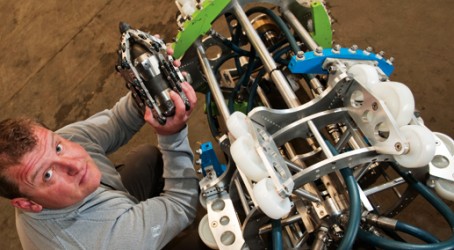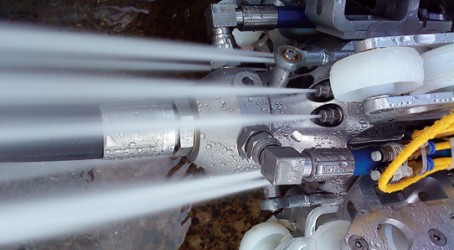Articles
Roadworks are the bane of motorists’ lives. At any given time in any town or city, you could almost guarantee there will be a band of merry men in hard hats clattering their way through tarmac with pneumatic drills. And behind them will be an angry snake of drivers.
Much of this work has nothing to do with improving the state of the roads – it is often utilities firms gaining access to the labyrinth of pipes and cables beneath the surface. While such maintenance work is vital, it’s the seemingly uncoordinated approach to planning and the length of time it takes which never fail to annoy.
A small engineering firm in the North-east has developed a technology that could go a long way to helping utilities firms reduce the disruption of maintenance work. Engineers at Gateshead-based Hydrascan have created a tethered “pig”, originally developed from technology used in the oil and gas industry, that enables contractors to clean water mains pipes between 6 and 60 inches in diameter.
The Typhoon system has proved well suited to the urban environment. It is quick and easy to set up and requires only a single entry point to clean up to 1km of pipe at a time. This, says Hydrascan, dramatically reduces the amount of excavation required and therefore the amount of traffic re-routing.
“Typhoon has a very small footprint – we only need to dig up a small excavation of between 2-3 metres by 2 metres,” says Neil Stutchbury, technical director at Hydrascan.
For Typhoon to work, a hole is dug above the pipe, a section is removed and the pipeline is drained. The pig is placed in the open pipe and high-pressure water enters through an umbilical pump arrangement to be expelled at a velocity of between 0.5m/s-2m/s to a target area up to a maximum of 500 metres from the insertion point.
An onboard valve is then switched and pressurised water is fed to a series of manifolds arranged radially to cover the internal surface of the pipe bore. Connected to each manifold is an array of fan jets. When fed with pressurised water the jets clean the circumferential pipe bore in a single pass as the vehicle is winched back to its launch point.

Typhoon obtains recycled pressurised water from a pair of high-pressure pumps mounted on a recycling vehicle. The bulk of the water used to clean the pipe returns to a collection tray in the hole where it is recycled, with solids – deposits of manganese, iron and aluminium – separated out while the clean water is reused for the next cleaning run.
The Typhoon system can clean all lined and unlined water pipes. The set-up varies with the lining type, being more or less “aggressive” as appropriate. The water pressure, the angle of the jets and the distance of the radial manifolds from the pipe wall are all controllable so that the system cleans without physically affecting the pipe lining. Additionally, because the system works on an umbilical basis compared to a winched system there is no sawing effect when the hose passes round the bend.
“The cleaning process is totally controllable,” says Stutchbury. “So if you had, say, a section of pipe lined by a weaker material such as bitumen and you didn’t want it spray-cleaned, the pig could be shut off and driven past before being started up again and recommencing cleaning. This controllability ensures the integrity of the pipeline.”
Typhoon has been used exclusively by Northumbrian Water as part of its four-year, £30 million mains cleaning programme. Stuart Tilley, Northumbrian Water project manager, says it has been successful at carrying out high-specification cleaning over long lengths and has proven adept at negotiating bends, valves and fittings in the network. The technology is attracting interest from other water authorities, such as Wessex Water, which are gearing up for their AMP 5 period (2010-15) of maintenance spending.
“We have held detailed discussions about Typhoon with all the other major water companies in the UK,” says Stutchbury. “And we are continually looking at ways to improve the performance of the pigs, enabling them to travel even further down the pipeline.”
